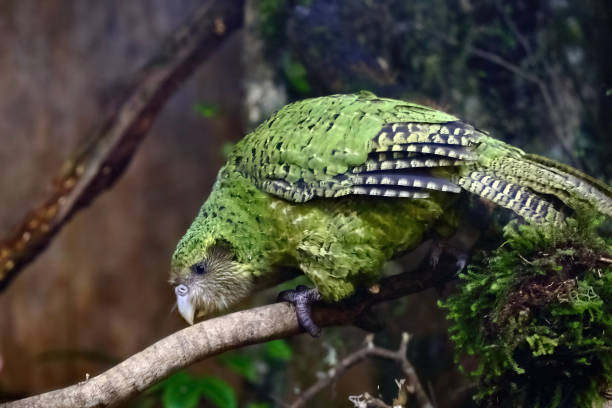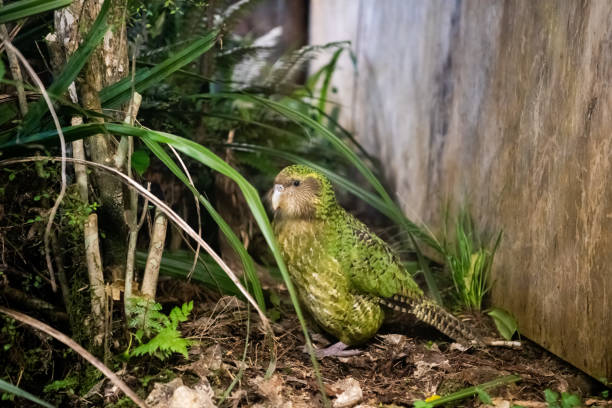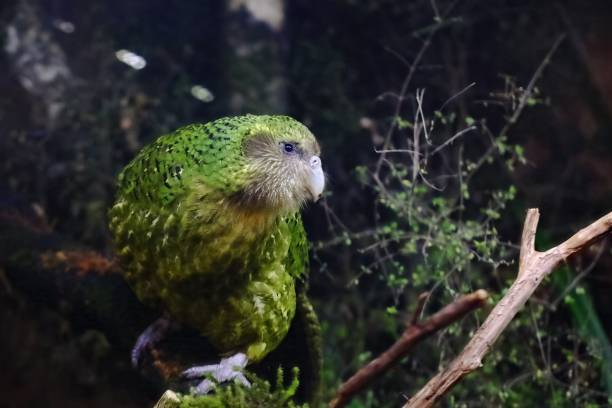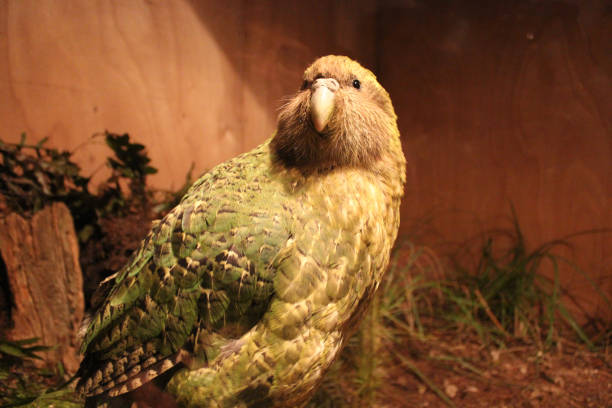The kakapo is a nocturnal, flightless parrot found only in New Zealand. Known as the owl parrot, it’s the world’s heaviest parrot and a master of camouflage. Once widespread, this giant parrot is now critically endangered, surviving only through intensive conservation efforts.
Table of Contents
Scientific Classification
- Common Name: Kakapo
- Other Names: Owl Parrot, Flightless New Zealand Bird
- Kingdom: Animalia
- Phylum: Chordata
- Class: Aves
- Order: Psittaciformes
- Family: Strigopidae
- Genus: Strigops
- Species: Strigops habroptilus
Description / Physical Description
The kakapo (Strigops habroptilus), often called the owl parrot, is a remarkably large, flightless bird endemic to New Zealand. As the largest parrot in the world by weight, adult males can weigh between 2 to 4 kilograms (4.4 to 8.8 pounds), making them veritable giants among parrots.
Their plumage is a mottled, mossy green with yellowish undertones—an exquisite natural camouflage against the forest floor. This coloring is flecked with dark brown and black, enhancing their cryptic appearance. A pronounced facial disk of feathers encircles the kakapo’s large, dark eyes, giving it an owl-like visage—hence the nickname “owl parrot.”
They possess short wings, used not for flight but for balance and breaking falls when climbing. A robust, curved beak designed for grinding fibrous plant material complements their zygodactyl feet, enabling them to climb trees with ease.

Range & Distribution
Once widespread across both the North and South Islands, the kakapo now survives only on predator-free offshore sanctuaries in New Zealand. These include Codfish Island (Whenua Hou), Anchor Island, and Little Barrier Island (Hauturu-o-Toi). Historic fossil records show that kakapos were formerly abundant, stretching from alpine zones to lowland forests.
Human settlement and introduced mammalian predators decimated their populations, reducing their native range drastically. Today, kakapos are emblematic among birds of New Zealand, representing the urgent need for species recovery.
Habitat
Kakapos inhabit temperate rainforest environments, where dense canopy and thick underbrush provide cover and food. They favor podocarp and beech forests, rich in ferns, shrubs, and native fruiting trees. The forest floor serves as their primary arena of activity, while tree trunks become climbing routes rather than flight paths.
Shelter is typically found in natural hollows, roots, or under ferns. These birds prefer secluded areas with minimal human disturbance, which has guided conservationists in choosing remote islands for relocation.
Diet
The kakapo is a herbivorous forager, exhibiting dietary preferences that shift seasonally. Its diet includes:
- Leaves (especially from rimu, kamahi, and horopito trees)
- Fern fronds and roots
- Bark
- Native fruits and seeds (notably from the rimu and kahikatea trees)
- Moss and fungi on occasion
The kakapo parrot uses its strong beak to grind vegetation into a fibrous pulp. Its gizzard further processes this material, ensuring maximum nutrient absorption from tough plant matter. During mast fruiting years, such as when rimu trees bear fruit abundantly, kakapos gorge on the nutrient-rich bounty—an event closely tied to their breeding behavior.
Behaviour / Lifestyle
Solitary and nocturnal, the kakapo leads a crepuscular-to-nocturnal lifestyle, emerging at dusk to forage under the moonlight. Males and females live independently, only coming together during the breeding season. This nocturnal routine minimizes predation and optimizes foraging opportunities.
Kakapos are ground-dwelling but highly adept climbers, often scaling trees to access fruits or resting branches. They create a network of trails within their territory—well-worn paths that weave through the forest floor like animal highways.
Their movement is slow and deliberate, and while they are capable of bursts of speed, they more often rely on stealth and camouflage for safety. Despite being a flightless New Zealand bird, their terrestrial agility and climbing ability serve them well in rugged forest terrain.

Lifespan
Kakapos are remarkably long-lived. Individuals often surpass 60 years of age, with some believed to live close to 90 years. This extended lifespan is unusual among birds and contributes to their slow reproductive rate. With late sexual maturity and long gaps between breeding events, each kakapo must survive for decades to sustain population growth.
Adaptations
Kakapos have developed several specialized traits in response to their island environment:
- Flightlessness: With no native mammalian predators, flight became unnecessary. Energy was better spent developing powerful legs for walking and climbing.
- Camouflage Plumage: Their green, mottled feathers blend seamlessly with forest foliage, helping avoid avian predators like the extinct Haast’s eagle.
- Nocturnal Activity: Activity at night provides cover and reduces competition.
- Polygynous Lek Breeding System: Males attract females by creating resonant “booming” calls that can travel kilometers, using thoracic air sacs to amplify sound.
Mating & Reproduction / Reproduction & Lifecycle
Breeding in kakapos is irregular and highly dependent on rimu fruit availability, often occurring only every 2–4 years. Males establish leks—territories where they perform elaborate vocal displays to lure females. Their deep, rhythmic booms are emitted over weeks, resonating through valleys in the still of night.
Once a female selects a mate, she nests alone, typically in a concealed hollow or under dense vegetation. She lays 1 to 4 eggs, incubating them for approximately 30 days. The chicks hatch blind and helpless, relying on the female for warmth and food. Fledging occurs after 10 to 12 weeks, but chicks may remain dependent on the mother for several more months.
Females do not breed annually, often skipping years due to the immense energy demand and sporadic food availability.

Predators
Kakapos evolved in the absence of terrestrial predators. However, with human arrival came invasive species:
- Stoats
- Rats
- Cats
These predators decimated kakapo populations by preying on eggs, chicks, and even adults. Their musky scent, ground-dwelling habits, and lack of flight made kakapos especially vulnerable. Conservation efforts have since relocated them to predator-free sanctuaries where these threats are eliminated.
Conservation Status
The kakapo is listed as Critically Endangered on the IUCN Red List. As of early 2025, there are just over 250 individuals alive. Every kakapo is tagged and monitored, with genetic management, artificial incubation, and hand-rearing now standard conservation tools.
The Kākāpō Recovery Programme, led by New Zealand’s Department of Conservation, has become a global model for endangered species recovery. Each bird has a name, identity, and documented lineage—a necessity in maintaining genetic diversity within such a small population.
Interesting Facts
- The kakapo is the heaviest parrot in the world.
- It is the only parrot known to use a lek breeding system.
- Kakapos are silent foragers, moving with quiet precision.
- Each male has a unique boom pattern, detectable by acoustic monitors.
- Their musk-like scent, once a natural trait, now inadvertently attracts predators.
As Pets
Kakapos are not suitable as pets. They are a fully protected species under New Zealand law, and ownership is illegal. Moreover, their specific dietary, environmental, and social needs cannot be met in captivity. The idea of keeping this giant parrot as a pet would undermine decades of conservation progress.

Classification of Species
The kakapo is the sole surviving member of the Strigopidae family’s Strigops genus, distinguishing it from other New Zealand parrots such as the kea and kākā (both in the Nestor genus). Its divergence dates back tens of millions of years, making it an ancient lineage in avian evolutionary history.
Subspecies
There are no recognized subspecies of the kakapo. However, fossil evidence suggests there may have been historical variations between populations on the North and South Islands. These are now extinct, and all living kakapos are part of a single, managed genetic pool.
The kakapo is more than just a bird—it is a living relic, an evolutionary marvel, and a conservation icon. Its survival hinges not on nature alone, but on human resolve and scientific innovation. As the world’s largest, flightless, nocturnal parrot, it occupies a singular place among the birds of New Zealand, inspiring efforts to preserve biodiversity across the globe.


